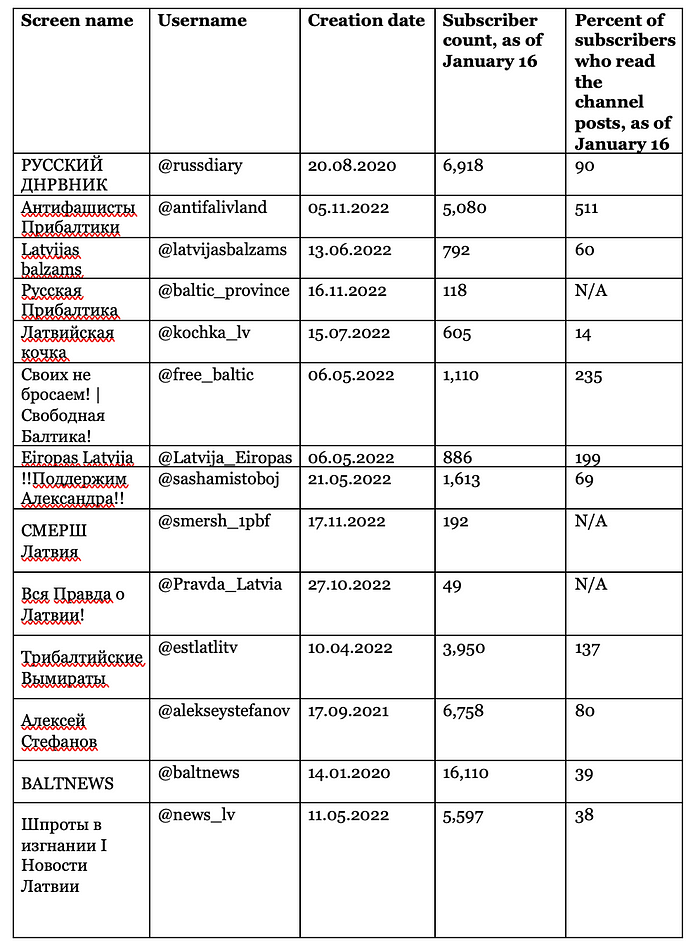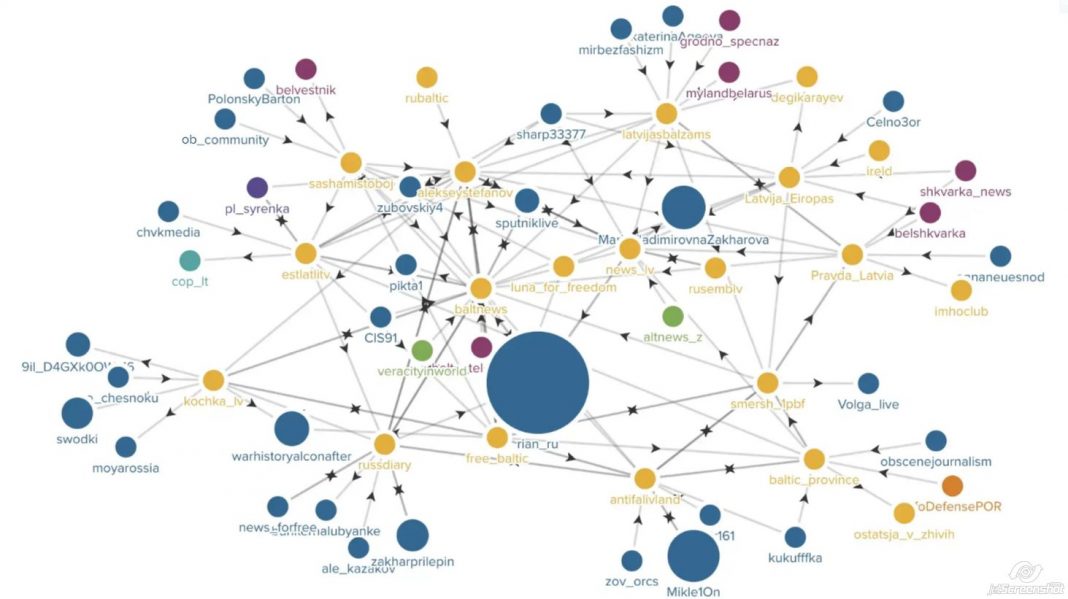Newly created pro-Kremlin Telegram channels target Russian speakers in Latvia
By Nika Aleksejeva, for DFRLab
The DFRLab identified at least fourteen Telegram channels that amplify each other’s efforts to label Latvia as a “fascist” regime. Eleven channels were created in 2022 after the Russian invasion of Ukraine. Four channels received views on their posts that exceeded their subscriber count, meaning their content reaches an audience beyond their direct followers.
The high view counts illustrate the relative success of the newly created pro-Kremlin Telegram channels that target Russian language users in Latvia. With growing polarization in Latvian society, the channels may be attempting to widen existing divisions further. Warning signs that Latvia is becoming increasingly polarized include the spread of online hate speech and a reluctance to speak openly and honestly, as documented in recent polling.
Telegram posts claim Latvia is becoming fascist
On January 11, a Telegram channel named The Baltic Antifascists (“Антифашисты Прибалтики”) published a TikTok video of a man in a mask calling on fellow Latvians to “fight the criminally fascist formation,” referring to the Latvian government. The man in the video speaks in Latvian, but the footage has Russian subtitles. The post was amplified by other Telegram channels, such as The Russian Diary (“РУССКИЙ ДНРВНИК”) and We don’t leave ours! | Free Baltics (“Своих не бросаем! | Свободная Балтика!”), according to TGStat, a Telegram analysis tool.

Screengrab of a Telegram post calling on Latvians to fight their “criminally fascist” government, left, and amplification analytics from TGStat, right. (Source: Антифашисты Прибалтики/archive, left; TGStat/archive, right)
On January 12, The Russian Diary Telegram channel posted, “Most Latvians have not yet realized themselves in the role of sacrificial cattle, which the Riga authorities have prepared for trench slaughter.” The same post suggests that “Latvia is preparing for a war” and will “mobilize soldiers,” claiming it will “turn into a dictatorship” that “prosecutes any dissent including by Latvians.” The post also shared a link to a Telegram post by Baltnews, a Kremlin-owned media outlet in Latvia.
The article is about Latvian parliament permitting a criminal investigation into newly elected parliamentarian Glorija Grevcova, who lied about her education and occupation to the Latvian Central Election Committee. Grevcova has previously released TikTok videos criticizing the Latvian government, advocating against demolishing a Soviet monument in Riga, and being elected from the Stabilitātei! (For Stability) “Russian” party, as the Russian Diary’s post suggested.
The Russian Diary post was shared on the Telegram channels We don’t leave ours! | Free Baltics channel, Baltnews, and Latvijas Balzams.

In turn, the Telegram channel Latvijas Balzams posted a list of reasons why Edgars Bleiders, a pro-Kremlin Latvian TikToker detained on January 9 for systematic propaganda, was unlawfully detained. One of the listed reasons was “speaking about Russophobia and nationalism, the lack of freedom and democracy in Latvia.” The post was shared by the Telegram channels The Baltic Antifascists; We don’t leave ours! | Free Baltics, !!Support Alexander!! (“!!Поддержим Александра!!”), and Latvian bump (“Латвийская кочка”). The channel !!Support Alexander!! was created for Aleksander Dubyago, a young Latvian detained by police for glorifying Russia on May 10, 2022, one day after the Soviet Victory Day celebrations in Riga. Authorities released Dubyago on January 9, 2023.

The Telegram channels
The DFRLab reviewed the Telegram channels that republished the posts discussed above and identified further channels that share similar narratives and focus on the Baltic states or Latvia. The channels included Russian Baltics (“Русская Прибалтика”); Europe’s Latvia (Eiropas Latvija); Sprats in Exile | News of Latvia (“Шпроты в изгнании | Новости Латвии”); Baltnews; SMERSH Latvia (“СМЕРШ Латвия”); The Whole Truth About Latvia! (“Вся Правда о Латвии!” ); Three Baltic Die-outs (“Трибалтийские Вымираты”); and Aleksei Stefanov (”Алексей Стефанов”), a journalist at Kremlin-owned Rossiya Segodnya focusing on the Baltic states.
TGStat provided information about the top five incoming and outgoing mentions for each of the fourteen channels identified in this investigation. The list of top incoming and outgoing mentions varies based on Telegram channel size and activity.

https://flo.uri.sh/visualisation/12499778/embedData visualization of incoming and outgoing mentions between Latvian channels within the broader context of established pro-Kremlin Telegram channels. (Source: @nikaaleksejeva/DFRLab via Flourish)
Baltnews was the most amplified Telegram channel. It appeared in the top five outgoing mentions for twelve of fourteen channels. Aleksei Stefanov was the second most amplified channel, with eight out of fourteen channels having it as a top outgoing mention. Sprats in Exile | News of Latvia was third, with seven channels having it among their top outgoing mentions. These three channels all operate as a news provider to some degree, so it is not unusual that other channels use them as sources.
In terms of top incoming mentions, We don’t leave ours! | Free Baltics was the top amplifier for five of the fourteen channels. The Russian Diary was also among the top amplifiers for three channels.
Meanwhile, channels like !!Support Alexander!! And Latvian bump were not listed among the top five incoming or outgoing mentions.

Eleven of the fourteen channels were created in 2022. Three of them — The Baltic Antifascists, Russian Baltics, and SMERSH Latvia — were created in November 2022.
The most successful channel in terms of growth and engagement is The Baltic Antifascists. In two months, it attracted 5,080 subscribers, while its post readership rate is 511 percent, suggesting that many more people who aren’t direct subscribers are reading each post as they are shared to other channels. This performance is especially striking when compared to BALTNEWS, which garnered more than 16,000 subscribers over two years but has a readership rate of 39 percent, despite it being the most amplified channel in this investigation.
By Nika Aleksejeva, for DFRLab
Nika Aleksejeva is Resident Research Fellow in the Baltics, with the Digital Forensic Research Lab.





